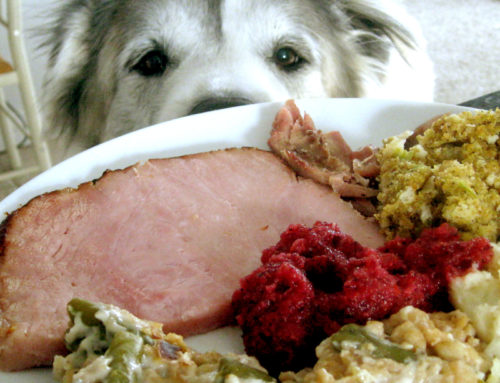Do You Know How to Feed Your Pets in the Spring?

Springtime. In addition to changes in the weather and changes in the length of the days and nights, dietary changes are in order as well. In Traditional Chinese Medicine theory, one should eat seasonally, and adapt the diet to accommodate the physiological challenges that the body will face each season.
Read on to learn what this means for your pet, and how to adapt your pet’s diet properly to best ensure a comfortable transition into the Spring.
Five Things to Remember During a Cold and Damp Spring
1. In a cold environment, your pet’s metabolism will slow down. You may want to consider feeding less food, especially if your pet isn’t getting as much exercise as he or she normally would during the warmer months.
2. Being in cold or damp environments causes more pain for pets with preexisting conditions, like arthritis. Animals with Hypothyroid disease are especially sensitive to cold weather (and may be sluggish or reluctant to move).
3. When the body is exposed to cold, physiologically the first thing that occurs is “contraction” of skin (goosebumps) and muscles with the constriction of blood vessels. Energy (Qi) and/or blood flow can be constricted in the channels of the muscles (trigger points), causing pain in these areas.
4. In cold and damp climates, muscles will be tight and contracted. This can mean that your pets will have a limited range of motion, so they may need extra time to “warm up” before being able to move properly. Many dogs will often have a stiffer gait in these climates and will have trouble getting up from a down position.
5. Dogs are more likely to suffer from urinary tract infections. As the weather remains cold and wet, some pet caregivers will be less inclined to take their dogs out for walks to go to the bathroom, and a lot of dogs will “hold it” longer than they should. Some dogs will start licking themselves to alleviate the pressure of having to pee, and that will introduce bacteria into their urinary system.
Five Tips to Help Your Pet Be Comfortable

1. Massage problematic muscles with stimulating herbal liniments, or soak the area in a warm bath with Epsom salts.
2. Feed foods that are warming, stimulating, circulation (Blood and Qi) promoting, and tonifying in energetic properties. Examples are lamb, lamb kidneys, chicken, chicken livers, turkey, pumpkin or yellow squash, asparagus, and kale.
3. Add warming spices (i.e. ginger, basil, or fennel) to add “heat” to the diet if you are feeding meats and veggies that are more energetically cooling or neutral.
4. Don’t give your pets food straight out of the fridge. This robs your pet’s body of heat and Qi, and could worsen the intensity of ailments like colitis, asthma, or diabetes. Always warm the food up before feeding.
5. Don’t let the inclement weather stop you from taking your dog out to pee on a reasonable schedule. Give your indoor dog a bathroom break every 4 hours. This is ideal for most dogs without ongoing urinary or digestive health issues.
If your work schedule is a normal 9 am to 5 pm commitment, please consider giving your indoor dog a pee pad to relieve himself or herself while you’re away at work. It is all too common for indoor dogs to have to “hold it” for 10 hours or more while pet caregivers are away at work, commuting in traffic, or running errands. Remember that you yourself would have a very hard time holding it for such a long period! Don’t force that on your dog!
You can also use cranberry to prevent urinary tract infections if your dog has to “hold it” for over 6 hours in the house. Supplementing with cranberry capsules may help prevent bladder infection because it reduces the likelihood of bad bacteria getting established in the body.
Dosage:
- 100 mg twice a day for a tiny dog or cat
- 250 mg twice a day, for a medium-sized dog like an Australian Cattle Dog
- 500 mg twice a day, for a large dog like a Golden Retriever
- 1000 mg twice a day, for an extra large dog like a German Shepherd
Below, you’ll find a recipe for one example of a seasonally appropriate meal for your pet. Give it a try.
Beef & Broccoli Cold/Damp Weather Recipe
Ingredients: Beef – 3 cups (chuck roast, cubed)
- Beef Kidney* – 1 cup (soaked overnight)
- Brown Rice – 2 cups (uncooked)
- Broccoli – 2 cups
- Celery – ½ cup
- Parsley – ¼ cup fresh or 1 tablespoon of dried flakes
- Ginger (dried)** – ½ teaspoon
- Garlic** – 1 clove
- Soybean oil (organic only) – 3 tablespoons (substitute coconut oil if your dog is allergic to soy)
- Water – 4 cups
Directions: In a large stewing pot, brown beef in the oil, garlic, and ginger for about 5 minutes on medium high heat. Add all the rest of the ingredients, including the kidneys. Bring to a boil (add more water to cover ingredients if needed). Reduce heat to low, cover, and simmer for about 1 hour (until the rice is well done). Stir every 10 – 15 minutes while simmering.
*To get rid of the urine smell when cooking kidneys, first cut up the meat, then rinse well with cold running water. Soak overnight in a mild green tea solution, then rinse off the tea before cooking.
** This recipe is designed for dogs. To feed this recipe to cats, omit the ginger and garlic (because they likely won’t eat it if it contains these aromatics). Once cooked, add the mixture to a food processor and make it into a paste to make it more palatable for kitties. Although we recommend raw foods for cats in general, this is a good springtime warming recipe.



